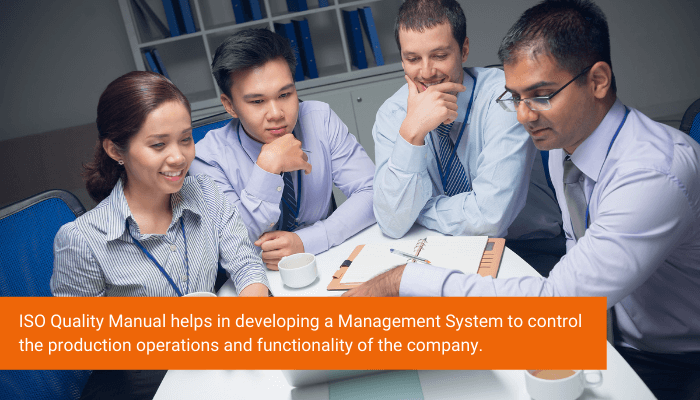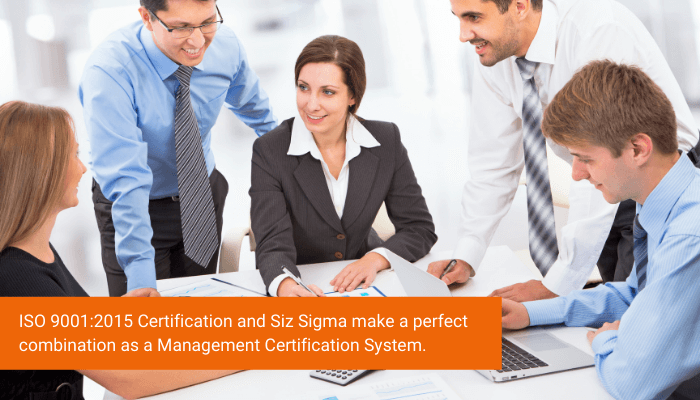Integrating Six Sigma into the Quality Management System (QMS) helps in preventing the occurrence of any nonconformities. The system performance will also increase dynamically upon the integration.
Quality is an essential component every organization must strive to keep up. It differentiates a company from the competition. The enhanced quality of products and services helps the company grow the business.
How do ISO 9001:2015 Certification and Six Sigma help Organizations?
More customers will come for the product or service. The superior products and services that exceed customer expectations help in growing a business.
Business profitability, increase in revenue, and productivity is all interlinked for achieving business growth. The Quality must be the top priority for organization to gain new customers consitently.

There are various methodologies and techniques that will help improve the quality of the management systems in the organization. ISO 9001:2015 Certification and Six Sigma are must-haves for every organization.
ISO 9001:2015 is a system for managing quality, whereas Six Sigma is a methodology for process improvement. They are complementary to generating exemplary results in organizations.
What is Six Sigma?
Six Sigma is a methodology for process improvement that aims at eliminating defects at 3.4 defects per million counts. It aims to make the organization’s process more efficient and enhance performance.
Six Sigma is a statistical and data-driven approach that uses the process model Define-Measure-Analyse-Improve-Control (DMAIC). It is an effective way of problem-solving and process improvement.
ISO 9001:2015 Certification – Key Highlights
ISO 9001:2015 Certification helps organizations to practice continual improvement. It also enables companies to standardize their business operations and achieve consistency in production.
It helps organizations to develop international quality products and services. The Quality Manual preparation and ISO Certification Process help in achieving the desired result.

ISO Quality Manual helps in developing a Management System to control the production operations and functionality of the company.
The Quality Management System uses Plan-Do-Check-Act (PDCA) Model. The effectiveness of ISO 9001 Certification will reflect in the organizational performance and customer satisfaction.
Improvement of quality within the organization along with the six sigma business improvement process will support the process of continuous improvement.
Quality Management Standard VS Six Sigma Certification
| ISO 9001:2015 Certification | Six Sigma Certification |
| Guidelines for ISO 9001 provide steps for the implementation of the QMS System. However, it does not suggest any tools or techniques follow for maintaining continuous improvement. | The Six Sigma method provides the how-to information for implementing a continuous improvement. |
| ISO 9001 Standard provides a checklist to follow for ISO Audit and implementing the QMS Successfully | It is a collection of process improvement tools and techniques that can be used along with the ISO 9001 standard or independently. |
| ISO 9001 covers a large scope at an organizational level. It takes care of the overall operational processes. | Whereas, Six Sigma is more granular level and individual processes are considered. It emphasizes continuous improvement and enhancing processing efficiency. |
| ISO 9001 Uses a Plan-Do-Check-Act Cycle (PDCA). The existing management system will be transformed by the ISO 9001 certification. The quality aspect is given utmost importance in ISO 9001 certification | Six Sigma follows Define, Measure, Analyze, Improve, and Control (DMAIC) Process. Reducing errors and standardizing operations are key goals. |
ISO 9001 and Six Sigma –Different Scope.
ISO 9001 is an internationally recognized Quality Standard that will help in developing a Quality Management System. It is a large-scale organizational level Certification that covers all departments, employees, suppliers, etc.
Six Sigma is a set of tools and techniques used to improve business processes. It is used as a product standardization tool and a methodology to reduce organizational waste. It helps in enhancing process efficiency in a manufacturing unit.
How Lean Six Sigma will help improve the business?
Six Sigma Certification is a management principle to improve business performance. The Lean or Zero waste concept is in line with Six Sigma principles of enhancing process efficiency. It has a set of highly effective techniques, tools, and methods for process improvement.

ISO 9001:2015 Certification and Six Sigma make a perfect combination as a Management Certification System. It blends along well and impacts the business on a positive note by growing business.
The ISO Auditors can implement ISO 9001 Certification after a meeting with the management. The team can then include the Six Sigma tools and techniques and practice continuous improvement.
Connecting ISO 9001 and Six Sigma
The ISO 9001 works on 8 core principles focusing on customers, leadership, process, management, continuous improvement, performance measures, and good supplier relation.
Similarly, Six Sigma aims at reducing organizational waste and enhancing resource utilization. It has a certain set of tools and techniques with zero-waste generation goals generation goal.
The ISO Quality Management System Standard is in line with the Six Sigma techniques in terms of operational goals. Both of the principles effectively support organizations to enhance business growth and productivity.
ISO 18404:2015 – Six Sigma and Lean Implementation
To further standardize the Six Sigma and Lean Certification. ISO has developed a new standard specifically for lean and six sigma professionals and organizations aiming for getting the ISO 18404:2015 Certification.
The Six Sigma Certification includes Quantitative methods that help in process improvement. It provides the key competencies for organizations concerning six sigma and lean implementation
This Certification Standard defines the competencies for the specific levels of Six Sigma, and Lean practices for individuals and at organizational levels.
Based on the proficiency, experience, and project scope, the individual can choose between Black Belt, Green Belt, and Lean practitioner for themselves and the organization.
To know more about integrating ISO 9001:2015 Certification with Lean Six Sigma Certification, talk to our expert team of ISO Consultants right away!
Contact Us: Aurion ISO Consultants



